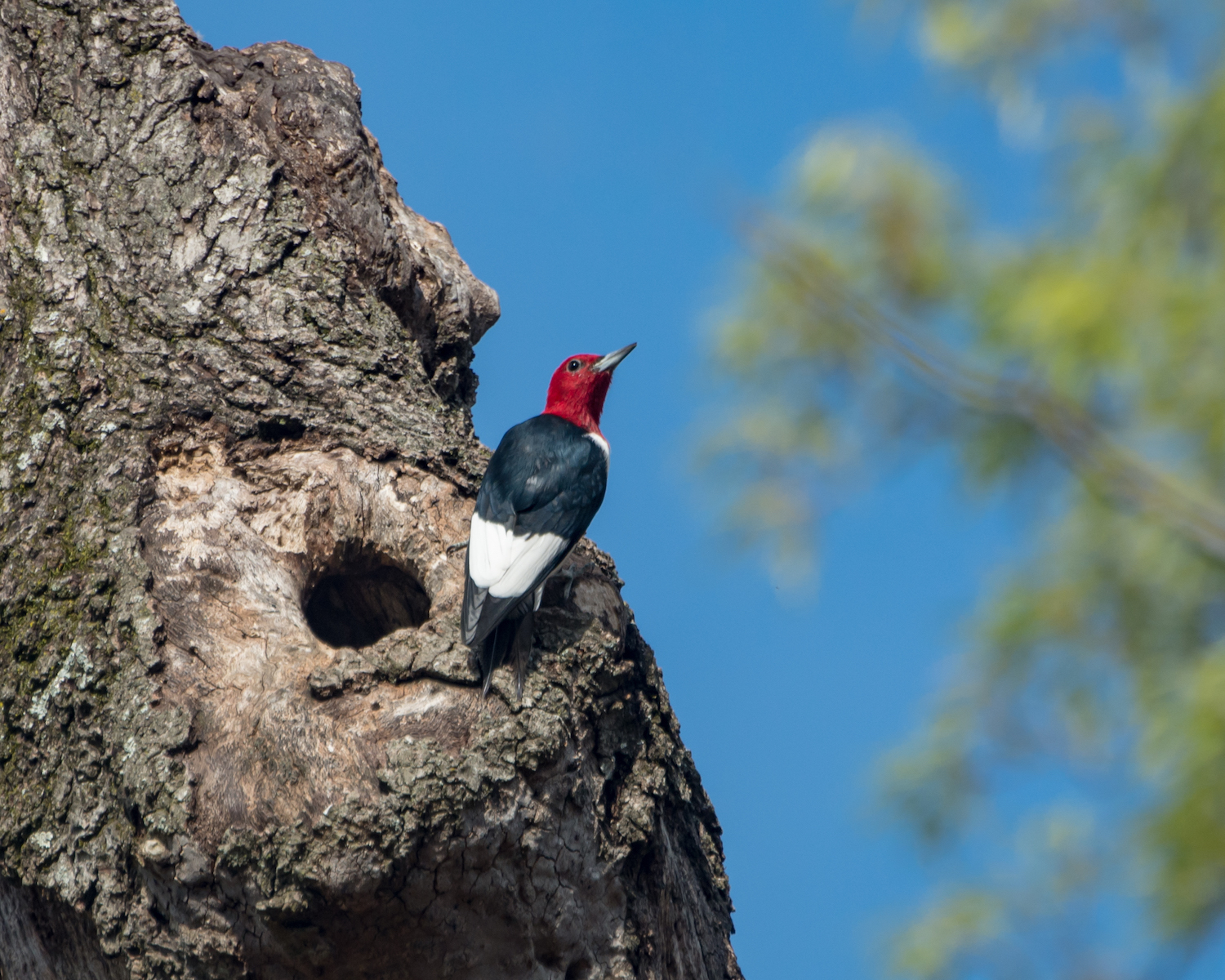Save the Redheads!
Once abundant in the Central and Eastern United States, the Red-headed Woodpecker has suffered a sharp decline in population and is considered Near Threatened by the International Union for Conservation of Nature and Natural Resources (IUCN). Even more discouraging, according to the National Audubon Society, recent surveys show that this trend is continuing. Conservation efforts are necessary in order to protect the population of this beautiful bird.
Red-headed Woodpecker
© Miranda Studstill
According to the Cornell Lab of Ornithology, "Red-headed Woodpeckers declined by over 2% per year from 1966 to 2014, resulting in a cumulative decline of 70%, according to the North American Breeding Bird Survey." Experts have cited several possible reasons for the decline, one of which is the reduction in nut-producing trees, which is a staple of their diet. In the fall, Red-headed Woodpeckers gather acorns, beech nuts, and other nuts and store them in crevices and tree cavities to eat throughout the year. As more trees are cut down to make room for residential and office space, many birds, including the Red-headed Woodpecker, suffer from the loss of not only a food source but also potential nesting sites. This loss of nesting habitat can lead to fierce competition among birds, which is cited as a reason for declining numbers in several bird populations. Red-headed Woodpeckers will occasionally use natural tree cavities for a nest, but when building a nest, they prefer trees that are dead or partially so, also known as "snags". According to StanTekiela in his Birds of Alabama Field Guide, Red-headed Woodpecker bills are not as adept at excavating holes as other woodpeckers, therefore they prefer dead or rotten tree branches when building their nests. As more people trim limbs and have dead trees removed, the Red-headed Woodpecker in particular has been negatively impacted. With fewer trees available, utility poles are commonly excavated for nesting sites instead. Unfortunately, according to Fred J. Alsop III in his book Birds of North America, newer poles are often coated with creosote, an oil distilled from coal tar, to preserve the wood which is lethal to eggs and young birds.
Red-headed Woodpecker guarding a tree cavity
© Miranda Studstill
SAVE THAT SNAG!
One organization is focusing on reversing the decline of this beautiful bird through The Red-headed Woodpecker Recovery Program. This program was established as a Special Committee of the Audubon Chapter of Minneapolis, MN. According to their site, "Our initial focus is red-head recovery in Minnesota and the upper midwest. But we are happy to serve as a focal point for red-head recovery nationwide; until we get overwhelmed!". One of their initiatives is to encourage land owners to Save That Snag! They have created an important document to help educate the public about the importance of snags to a healthy forest ecosystem, guidelines for snag management, and how to create a snag. You can learn more about their goals and objectives at www.redheadrecovery.org.
A snag refers to a standing dead or dying tree
© Miranda Studstill
Not everyone reading this is in a position to save a snag, but that doesn't mean that there aren't ways to get involved and help protect the population from further decline. Here are a few ways that you can get involved:
1) Support the efforts of The Red-Headed Woodpecker Recovery Program, The National Audubon Society, or your local Audubon chapter, or other land conservation organizations in your area. You can make a donation, become a member, or assist in education and advocacy efforts.
2) While bird houses are not substitutes for natural habitat, particularly trees and snags, you can help reduce the competition for nest cavities by providing shelter for birds that are in need of a nesting site. Birdhouses are an inexpensive purchase, but if you are handy, consider building your own nest box. According to birdhouses101.com, "the recommended dimensions for Red-headed Woodpecker nest boxes are: 6” x 6” (floor), 14” (distance from floor to ceiling), 2” (entrance hole diameter), 11” (distance from floor to the top of entrance hole). Ventilation opening should be placed on the floor and under the roof. Wood chips need to be littered on the floor for a 'natural cavity' feel. Nest boxes should be mounted out of reach, about 8 feet or higher, on trees found in a clearing or on woodland edges."
3) If you see a Red-headed Woodpecker, report the sighting on eBird, an online database that provides important information to scientists and researchers. It's easy to do. Go to www.ebird.org to learn more.
4) Plant a tree. Or several trees. Choosing nut or fruit bearing trees provide both food and shelter for birds.
Your efforts can make a difference in preserving the population of the Red-headed Woodpecker
© Miranda Studstill
Resources and Further Reading:
https://www.allaboutbirds.org/guide/Red-headed_Woodpecker/lifehistory
http://www.birdhouses101.com/Redheaded-Woodpecker.asp
http://www.ebird.org
http://www.iucnredlist.org/details/22680810/0
https://www.nature.org/newsfeatures/specialfeatures/animals/birds/red-headed-woodpecker.xml
http://redheadrecovery.org
Alsop, Fred J. (2001). Birds of North America. New York, NY: DK Publishing, Inc.
Tekiela, Stan (2006). Birds of Alabama Field Guide. Cambridge, MN: Adventure Publications, Inc.



